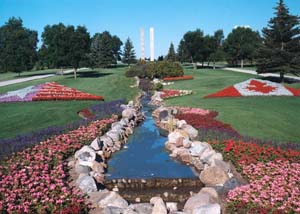INTERNATIONAL PEACE GARDEN

Floral Flags, International Peace Garden
View largerThe International Peace Garden was created to commemorate more than 150 years of peace between the United States and Canada. Straddling the world's longest unguarded international boundary, it is situated in the scenic Turtle Mountains between North Dakota and Manitoba and halfway between the Atlantic and Pacific Coasts. Just inside the main entrance, beneath the flags of both nations, a marker is inscribed: "To God in his glory, we two nations dedicate this garden and pledge ourselves that as long as man shall live, we will not take up arms against one another."
Inspiration for the garden began with Dr. Henry Moore of Islington, Ontario. On July 14, 1932, his idea became a reality when over 50,000 people gathered to dedicate this monument to peace. Spreading over 2,339 acres, the garden displays a spectacular mosaic of flowers, trees, fountains, and paths. Visitors can stroll through the formal gardens, camp under aspens and oaks, and even get married in the Peace Chapel. The most prominent structure, the Peace Tower, with its four pillars, stands more than 100 feet tall right on the international boundary. More than a horticulturalist's dream, the garden hosts concerts, arts festivals, and renowned youth summer camps in music and athletics. As many as 250,000 people visit the garden each summer and help renew this pledge of friendship between Canada and the United States.
International Peace Garden website.
Sonja Rossum University of Nebraska-Lincoln
"A Garden for Peace." North Dakota Horizons 21 (1991): 8–15.
Previous: Homestead National Monument of America | Contents | Next: Last Best West
XML: egp.ii.037.xml
